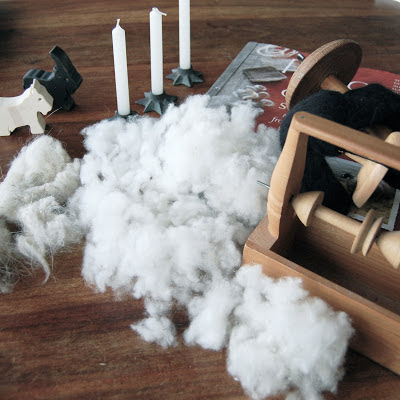 Cashmere! Seriously! I have to admit my ignorance. I really thought that cashmere came from a special breed of ... well, I probably thought it was sheep. But it's goats. I really didn't know that it isn't the breed that determines if the wool is cashmere or not, but basically the combination of fiber diameter (in microns) and the length of the fiber. Cashmere is between 14 and 18,5 microns (human hair is around 50 microns) and the length of the fiber should be no less than 32mm (11/4") in relaxed state (crimped).
Cashmere! Seriously! I have to admit my ignorance. I really thought that cashmere came from a special breed of ... well, I probably thought it was sheep. But it's goats. I really didn't know that it isn't the breed that determines if the wool is cashmere or not, but basically the combination of fiber diameter (in microns) and the length of the fiber. Cashmere is between 14 and 18,5 microns (human hair is around 50 microns) and the length of the fiber should be no less than 32mm (11/4") in relaxed state (crimped). The Icelandic goat is a small breed, originally Norwegian. They have very long and coarse guard hairs, but under that they have high quality luxurious cashmere fiber. In recent tests the fiber qualified as cashmere in terms of the diameter, but comes in just short in the length. So technically it can't be called cashmere, but I don't care. It's absolutely lovely to the touch and I can't wait to try to spin it.
Since Iceland was very isolated for a number decades our livestock, which came with the Vikings just after 800 AC, has evolved to be uniquely Icelandic. We therefore have our distinct horses and sheep, and also have our wonderful Icelandic cattle, the very colourful poultry and the cheerful Icelandic goats. Importing foreign animals is not allowed, mostly to prevent diseases since past experiments have unfortunately brought us diseases that are still being battled today. Just a few years ago some harmless virus came from Europe, probably via unclean equipment, and was transmitted to the defenseless Icelandic horse, killing large numbers of them. So even if the laws about animal imports can sometimes be annoying and sound very strict, experience has taught us that we can not be too careful. And at least we are still free of rabies in this country.
The Icelandic goat is an endangered species. In 2011 there were 818 goats in the country and until breeding females number over 1000 they will be in danger of extinction. There are a few individual farmers who are breeding goats in order to preserve them, mostly working without much support from government. The breeding now, is only aimed towards reducing inbreeding and trying to get the most variabilty into the heard. Hopefully that will be successful and the breeders can then concentrate on specific aims like the quality of the wool or milk or meat. I recently visited one of the farm, the largest, Háafell.
Needless to say I fell hopelessly in love with these charming and sociable creatures. They are very cuddly amimals and litterally jump up on you to get a cuddle. I have been wanting goats for the longest time and now I know why. They are just like pets. And cute too. Even the large males are adorable with their large horns.
The survival of the Icelandic goats is of course hugely dependent on economic issues. Can they be bred profitably? Well, we'll have to see, but did buy quite a bit of wool as well as some cheese and meat. I also volunteered to come and comb the goats when the time comes to do that in April. In the meantime I've been busy cleaning the wool, both washing it and removing the coarser guard hair. The resulting fiber is temptingly soft and I really, really need to get better at spinning very soon so that I can make some lovely yarn for a sweater for myself.




SOme friends of ours gifted us with some Icelandic wool which I am making felted saop with. It is so wonderfula dn I know the felted soap will be magnificient. So wonderful I plan to keep it all for myself.
ReplyDeleteAh! I have yet to make felted soap and here I am with all this wool :)
ReplyDeleteWow!! what a treasure i stumbled up on here. Your work is so inspiring!! N I love how u source all ur material from the lap of nature. I specially like rhubarb root soaps..sadly i am not able to find it in my place,..n i belong to the warm-hot zone of the world!!! for now i make do with maddar root for a light pink soap...:) Keep doin what u do... :) cheers.
ReplyDelete